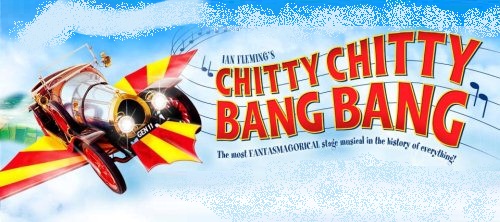
The real Chitty Chitty Bang Bang was built in 1921 by Count Louis Zborowski, perhaps the best known amateur racing driver of his time, who lived at Higham Place, a large country house, near Canterbury in Kent. The son of a Polish Count and American mother, Zborowski was an eccentric gentleman wealthy enough to own and race many cars both in Europe and America. He took racing very seriously but was known for his fun approach and colorful clothing (especially checkered golfing caps) so one could suggest similarities with Fleming's creation of Caractacus Potts. At Higham, along with his engineer Captain Clive Gallop, he built four aero-engined cars and called three of them Chitty Bang Bang. A fourth 'monster' car, also built at Higham, was called the Higham Special or Babs and was used in Parry Thomas' fatal attempt for the land speed record at Pendine Sands in 1927. This last car survives today, fully restored, and still 'takes to the concrete' at Brooklands on special occasions.
Chitty 1 was the first amateur aero-engined machine to achieve great fame at Brooklands race track. The 23 litre six cylinder Maybach Gotha Bomber engine was obtained from the WWI Disposals Board, and shoe-horned into a pre-1914 chain drive Mercedes chassis, which had to be lengthened to accommodate it. First appearing at the Brooklands Easter meeting in 1921 with a four seat body, and obviously inefficient exhaust system, it was described as 'a brutal car put together by a madman', but Count Zborowski was more astute than he first appeared. The car's initial shortcomings were probably a ruse to avoid ridicule if the car failed on its first time out. An unnecessary ruse though, as Chitty won two races and came second in another (behind another Zborowski car). The first win was the 100 mph Brooklands Short Handicap at a speed of 100.75 mph.
By Whitsun, a two seater duck's back racing body had been fitted and modifications included a cowled radiator and properly flowing exhaust system. The poor showing earlier and crudeness of the vehicle had fooled the handicappers and guaranteed him a place on the starting line with a ten second advantage. The new Chitty was even more successful and the Count trounced his competitors (especially a 350 hp V12 Sunbeam) in the first race. The advantage was removed for the second race but she was clocked at 120 mph down the railway straight. Despite further handicap revisions in the following months, Chitty continued to impress.
Chitty 2 was constructed in the Summer of the same year, similar to the first car but with a shorter wheelbase, an early Mercedes chassis and an 18.8 litre Benz BZ IV series aero-engine. Both Chittys ran at the autumn 1921 Brooklands meeting but for various reasons neither was successful on the day.
Chitty 2 never raced at Brooklands again but was kept by 'Lou' as a much loved and very fast road car. He even drove it deep into the Sahara in January 1922 on a tour undertaken with friends. After many years in America, Chitty 2 was loaned to the National Motor Museum at Beaulieu in 1992 and is now in private ownership.
During the 1922 Whitsun meeting at Brooklands, Chitty 1 achieved her fastest lap at 113.45 mph. She missed the August meeting but returned in September for what was to be her last outing. Brooklands was built as a record breaker's track - 100 feet wide concrete all the way round with a very steep, almost vertical in places, gradient on the two banked sections. In practice Chitty shed a tire and left the banking at high speed smashing straight through the timing box at the beginning of Railway straight. A track official named Mr. Chamberlain was in the box and saw the car coming but could not avoid being clipped as it crashed through, losing three of his fingers as a result. Chitty 1 was rebuilt but never raced again by the Count. He became part of the Mercedes team in 1924 and perished soon afterwards in one of their cars, before his thirtieth birthday, hitting a tree during the Italian Grand Prix. After his death, Chitty was purchased by the Conan Doyle brothers who were the sons of Sir Arthur, the author who created Sherlock Holmes. They ran her at a speed trial in the 1930's after which she was exhibited at Brooklands but subsequently abandoned outside. The elements took their toll and eventually someone sawed the chassis in half to get her gearbox for use in another car. A very sad end for a great vehicle and Fleming's inspiration for Coggin's Yard.
Brooklands race track in Weybridge, Surrey was the first purpose built motor racing circuit in the world and is now open as part of a 30 acre museum celebrating its history as the birthplace of not only British motorsport but also of British aviation.
Written by Mark Fox
www.mtishows.com